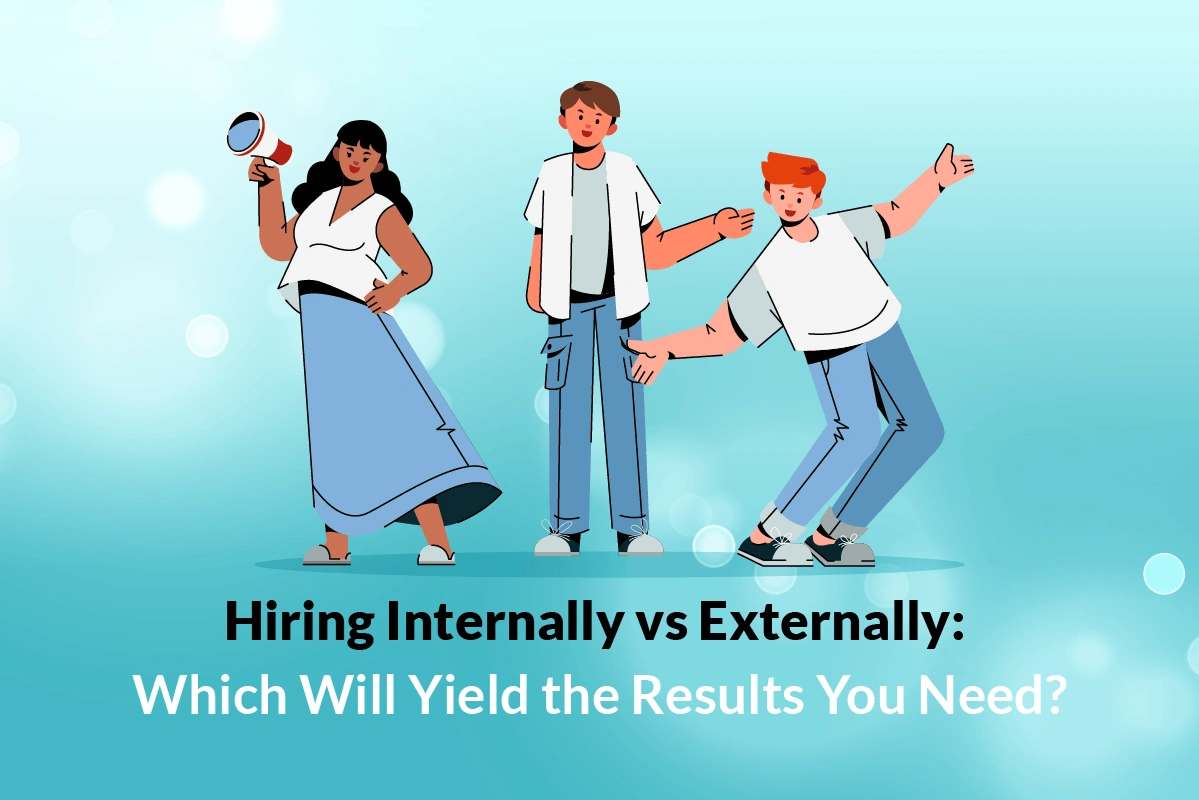Sourcing talent is a critical business decision that impacts culture, productivity, innovation, and growth potential. With so much at stake, it’s little wonder that companies are cautious about who they hire, often stressing the need for employees who “fit in” or “get it.”
Choosing between hiring internally or externally is a strategic decision that balances nurturing talent from within and gaining outside perspectives or skills.
Hiring externally and internally refers to two methods of hiring. A successful hire ensures that the company is appropriately staffed with qualified people capable of performing their job responsibilities. Beyond that, how you hire can have far-reaching and long-term impacts on your business.
Examining each hiring technique and the benefits and drawbacks can guide your decision to hire internally vs. externally.
Defining Internal Hiring and External Hiring
An internal hiring process fills job openings within a company from candidates identified from current staff. In contrast to external recruiting, which looks outside the company for qualified individuals, hiring internal talent often means shifting employees from one team to another or promoting them to newly formed roles. Internal recruiting can be used by businesses of all sizes to place experienced personnel in growth positions.
External hiring seeks to fill an available position with someone who does not currently work for the company. This can include posting a job, using a recruiting firm, or asking for referrals to identify available candidates.

Pros and Cons of Hiring Internally vs Externally
The decision to hire from within or go outside of the company often comes down to the benefits or drawbacks the company will experience. Weighing pros and cons might need to be considered on a case-by-case basis,. In some companies, the hiring approach a standard – sourcing first from internal candidates before looking outside of the company.
Consider the pros and cons of hiring internally and externally that employers need to consider:
Advantages of Internal Hiring
- Cost-effectiveness: Since internal candidates are already part of the company, there may be little to no expense involved in recruiting, advertising, and interviewing candidates. The company may also save money on training since internal candidates are already familiar with the company’s culture and operating procedures. By promoting from within, the company can avoid the high costs of external recruitment and focus on investing in its existing employees.
- Faster onboarding: Internally promoted employees can quickly transition to the new role without onboarding because they are already embedded within the company’s culture, and experienced with policies and procedures. Internal hires frequently have connections with other staff members and may take less time to integrate into new teams or form working relationships with coworkers. This may result in increased productivity and a smoother transition.
- Employee morale and retention: Employees are more likely to feel valued and invested in their work when they perceive opportunities for growth and advancement within the organization. Longer tenure and higher productivity may result from this sense of commitment and loyalty to the company. Each element helps create a productive workplace and increases employee retention.
- Utilizing existing talent: Promoting from within allows employers to find top performers who have already proven their abilities and dedication to the business. In addition to saving the time and money that would have been used for recruitment and onboarding, this also improves employee morale by showcasing and rewarding internal talent.
- Retention of corporate knowledge: Hiring from within ensures that valuable knowledge about accounts, clients, processes, and other critical information is leveraged. By promoting from within, employees bring their accumulated knowledge and experience, preventing the loss of valuable insights that could occur when hiring externally.
Disadvantages of Internal Hiring
- Limited talent pool: As a company’s needs grow or change, particularly for some highly skilled or emerging roles, one disadvantage of internal hiring is a limited talent pool. Existing employees may not have the knowledge, skills, or experience needed to step into a new role or to make an immediate impact. Looking internally only may mean missing out on individuals who could offer new perspectives, new ideas, or abilities that accelerate business growth. As a result, there may be stagnation and a lack of creativity.
- Potential for resentment and conflicts: Existing employees passed over for a promotion or job opportunity in favor of another internal candidate may feel undervalued and frustrated, leading to resentment towards the chosen candidate or management. To mitigate these risks, it is important for employers to communicate transparently about their hiring decisions and provide opportunities for feedback and discussion.
- Inadequate skill sets: While existing employees may have some of the necessary experience and knowledge for the position, they may not possess the specific skills required for the role. Hiring internally can sometimes result in inadequate skill sets or untested experience. This can lead to problems down the line if the employee struggles to meet the job requirements, leading to dissatisfaction and frustration for both the employee and the employer.
- Reinforcing an organizational culture: While hiring from within can help to maintain the current culture, it can also limit the diversity of thought and perspectives. Organizations risk becoming echo chambers that grow resistant to change without an influx of new ideas and approaches. To foster growth and innovation, businesses must balance preserving their culture and bringing in diverse ideas and talents.
Advantages of External Hiring
- Access to a diverse talent pool: Access to a diverse talent pool is a significant advantage of external hiring. Companies that cast a broader net can access a more extensive and diversified pool of talent that may not be available internally. External candidates provide different perspectives, experiences, and skill sets to the organization, which can add value and drive creativity.
- Fresh skills, ideas, and attitudes: External hiring can bring in new approaches and ideas that can benefit the organization in numerous ways. External candidates bring with them skills and experience gained from different industries or organizations, which can infuse new capabilities and inspire innovation, motivating others and stimulating growth within the company.
- Competitive edge: New ideas, views, and inventive solutions can provide the competitive edge organizations need. Companies that hire externally can pull from a broader talent pool that includes candidates from a variety of backgrounds, skill sets, and experiences. That can include valuable insights and know-how about the competition or market that give the company a competitive edge.
- Opportunity for organizational change: By hiring externally, organizations can shift existing norms and culture, in essence, hiring positive change. New outside hires can motivate or inspire existing employees to improve their performance to secure their positions or vie for promotions.
⇒ Maybe you’ll be interested in: What is An Inclusive Workplace? Benefits and Ways To Create

Disadvantages of External Hiring
- Increased costs: Competition for talent and selective employees can increase the cost of external hiring. Job postings, advertising, analyzing resumes, holding interviews, and checking references can all be time-consuming and costly. Even with the best screening and interviewing, there’s no guarantee the new hire will stay long enough or contribute enough value to balance the cost of hiring.
- Longer onboarding and adjustment period: To fully acclimate to culture, policies, and procedures, new hires from outside the company will require more time and resources than internal hires. They might also need additional training to acquire the knowledge required for their position and to discover how to collaborate successfully with team members. The employee’s ability to contribute to the success of the company may be delayed by this prolonged adjustment period, which could affect productivity.
- Potential for a cultural misfit: External hiring can bring in fresh perspectives and new talent, but it also comes with the risk of a cultural misfit. Every organization has its own unique work culture and values, and it’s important to screen candidates for soft skills and perspectives that might indicate they are a good fit for the company’s culture. When hiring externally, there is always a risk that the new hire may not be aligned with the company’s values, leading to issues with teamwork, communication, and overall morale.
- Risk of unsuccessful hire: Even with a rigorous hiring process, it is still possible to hire someone who does not perform as expected. This can lead to additional costs, including the time and money spent on recruitment and training. In addition, it can create a negative impact on the team morale and overall productivity.

⇒ Maybe you’ll be interested in Essential Hiring Tips For Businesses
Conclusion
Both hiring internally vs. externally have their advantages and disadvantages. Deciding which strategy is best for your organization will largely depend on the role being filled and your unique requirements. The best practice approach is to develop a balanced hiring plan that meets the needs of the business and its culture.
Stop looking. Start finding. Sorting through hundreds of unqualified candidates is the old way to hire. Boulo matches forward-thinking companies with hidden talent faster. Our proven, technology-driven recruiting platform puts qualified, diverse candidates in your inbox, and our pipeline of women and caregivers represents a 23M population you won’t find on other job boards.

